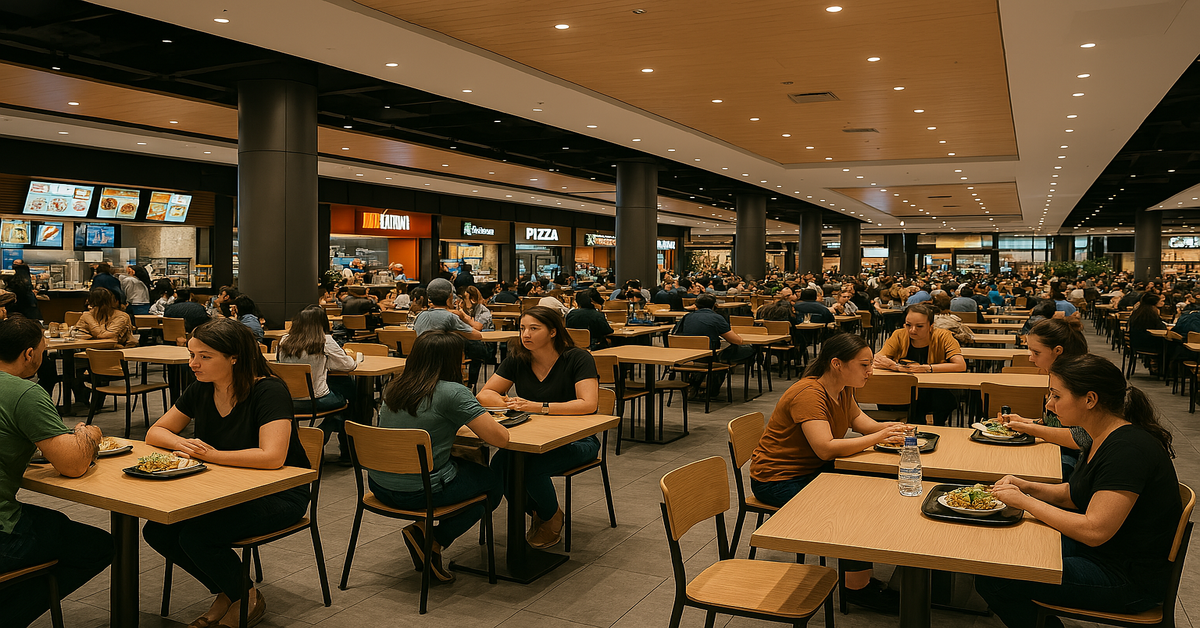Food courts have become a fundamental aspect of modern-day dining, retail, and leisure culture. These dynamic culinary hubs provide a centralized space where multiple food vendors operate, offering diverse menus under one roof. Found in shopping malls, airports, universities, office complexes, and urban centers, food courts cater to a wide demographic, from busy commuters to families seeking convenient meal options.
Over the decades, food courts have evolved from simple fast-food clusters to vibrant gastronomic destinations that embrace global cuisines, digital ordering systems, and creative architectural designs. They are no longer just a place to eat—they’re social meeting points, cultural samplers, and even economic incubators for new culinary talent.
This article explores the concept, history, structure, and cultural impact of food courts, examining how they have transformed the way we eat in shared public spaces.
Origins and History of Food Courts
Ancient Communal Dining Spaces
While the modern food court as we know it is a relatively recent phenomenon, the concept of communal eating spaces dates back thousands of years. Ancient civilizations, such as those in Rome and China, had bustling markets and communal dining halls where people could buy prepared meals and socialize.
In ancient Rome, thermopolia were establishments where hot food and drinks were sold—essentially the ancient version of fast food. These areas often had seating spaces and served busy laborers and travelers, similar to today’s food courts.
The Rise of the Modern Food Court
The modern food court concept emerged in the United States during the 1970s, primarily in shopping malls. As malls became popular centers of commerce and social interaction, there was a growing need for places where shoppers could conveniently eat without leaving the premises.
- The Paramus Park Mall in New Jersey, opened in 1974, is often credited with having one of the first food courts in America.
- These early food courts typically featured national fast-food chains such as McDonald’s, Pizza Hut, and Taco Bell.
The model quickly spread across the U.S. and globally, becoming an essential feature in malls, airports, and other high-traffic venues.
Structure and Design of Food Courts
Layout and Seating
Most food courts are designed with a centralized seating area surrounded by individual vendor stalls or kiosks. This arrangement allows patrons to:
- Order from different vendors
- Dine together regardless of food choice
- Enjoy open sight lines and an airy atmosphere
Tables are usually managed by the property, not individual vendors, which encourages a communal environment.
Vendor Types
Food court vendors can vary significantly depending on the location and theme. Common types include:
- Fast-food chains (e.g., Burger King, KFC)
- Ethnic food outlets (e.g., Chinese, Indian, Mediterranean)
- Health-conscious brands
- Dessert or beverage-focused stalls
Some food courts also feature “anchor vendors”, larger or more established restaurants that draw crowds.
Amenities and Facilities
Modern food courts often include:
- Free Wi-Fi
- Charging stations
- Self-cleaning dining areas
- Interactive ordering kiosks
- Trash and recycling stations
- Play areas for children (in malls)
High-end or urban food halls may also incorporate bars, live music, or open kitchens for a more immersive dining experience.
Types of Food Courts
Traditional Mall Food Courts
These are the most common and are typically found in regional and suburban shopping malls. They are dominated by:
- Chain restaurants
- High foot traffic
- Affordable price points
These food courts offer quick, convenient meals for shoppers and families.
Airport Food Courts
Found in airport terminals, these food courts serve travelers and are optimized for speed and portability. They often feature:
- Grab-and-go options
- 24/7 operations
- Local specialties to represent regional cuisine
College and University Food Courts
Campuses often include food courts in student centers. They provide variety and cater to dietary restrictions such as vegetarian, vegan, and gluten-free diets.
These food courts may accept student ID cards as payment and focus on affordability and nutrition.
Office Complex or Corporate Food Courts
Located within large business parks or skyscrapers, these food courts cater to working professionals. Offerings often include:
- Health-focused meals
- Coffee shops
- Quick service to fit short lunch breaks
Urban Food Halls
A recent trend, urban food halls are upscale, curated spaces offering gourmet meals, craft beverages, and artisan foods. Unlike traditional food courts, food halls emphasize:
- Chef-driven menus
- Local and sustainable sourcing
- Premium dining experiences
Economic Impact and Vendor Opportunities
Business Incubation
Food courts are fertile ground for culinary entrepreneurs. The lower overhead costs (compared to standalone restaurants) and steady foot traffic offer emerging chefs and vendors a chance to:
- Test concepts
- Build brand awareness
- Gather customer feedback
Many successful restaurant chains started as food court stalls.
Employment Generation
Food court’s generate thousands of jobs across various functions:
- Chefs and kitchen staff
- Cleaners and maintenance personnel
- Cashiers and servers
- Supply chain and logistics workers
Revenue for Property Owners
For landlords and mall operators, food court’s are a consistent revenue source. The blend of rent, shared utilities, and operational fees supports a stable tenant mix that enhances the property’s overall appeal.
Cultural Diversity and Culinary Fusion
Global Cuisine Under One Roof
Food court’s are often microcosms of the cultural landscape they exist in. A single food court might offer:
- Indian curries
- Japanese sushi
- Mexican tacos
- Middle Eastern shawarma
- American burgers
This variety allows diners to explore global flavors without leaving the city.
A Platform for Cultural Exchange
Beyond the food itself, food court’s often serve as platforms for:
- Sharing culinary traditions
- Bridging cultural gaps
- Celebrating festivals through food (e.g., Lunar New Year promotions)
Food court’s help foster multicultural understanding and appreciation.
Food Courts in the Digital Age
Integration of Technology
Modern food court’s have embraced technology to streamline operations and improve the customer experience. Key innovations include:
- Self-ordering kiosks
- Mobile app ordering
- Digital menus with nutritional info
- Table tracking systems
Delivery and Takeout Services
The rise of third-party delivery apps like Uber Eats and DoorDash has led many food courts to adopt hybrid models. Now, customers can enjoy food court meals at home or in the office.
Some locations have integrated dedicated pickup zones or ghost kitchens within food courts to serve online orders exclusively.
Challenges and Criticism
Competition from Standalone Restaurants
As the dining scene becomes more sophisticated, food court’s face competition from niche eateries and fast-casual concepts offering tailored experiences and ambiance.
Perception of Quality
Historically, food court’s were associated with fast food and perceived as offering lower-quality meals. This stigma has persisted, although newer food halls are working to change that.
Hygiene and Maintenance
With high footfall, cleanliness is a constant concern. Managing:
- Trash disposal
- Table sanitation
- Food safety regulations
…requires vigilant operational oversight, especially post-pandemic.
Sustainability and the Future
Eco-Friendly Initiatives
In response to environmental concerns, many food court’s are implementing green practices:
- Compostable containers
- Digital receipts
- Food waste tracking and donation programs
- Energy-efficient lighting and equipment
Some food court’s collaborate with zero-waste organizations to reduce their environmental footprint.
Future Trends
Looking ahead, food court’s are likely to evolve in the following ways:
- Hyper-local vendor selection to highlight community cuisine
- Rotating pop-up stalls for variety
- Interactive dining experiences (e.g., cooking demos)
- Subscription-based meal programs
- Augmented reality menus and AI-driven personalization
Global Food Court Destinations
Asia
Countries like Singapore, Malaysia, and Taiwan boast famous food court’s known as hawker centres. These are deeply ingrained in the local culture and offer:
- Affordable prices
- Authentic street food
- Communal dining
Singapore’s Lau Pa Sat and Maxwell Food Centre are world-renowned.
United States
The U.S. leads the global trend in modern food halls. Popular examples include:
- Chelsea Market in New York
- Grand Central Market in Los Angeles
- Time Out Market in Miami
These spaces blend food, art, and lifestyle for an immersive experience.
Middle East
Dubai and other Gulf cities feature high-end food court’s in luxury malls, such as:
- The Dubai Mall Food Court
- Mall of the Emirates
These spaces combine local favorites with international chains in air-conditioned, spacious environments.
Conclusion
Food court’s have come a long way from their humble beginnings in suburban shopping malls. Today, they are vital components of modern infrastructure—feeding millions of people daily while offering diverse, affordable, and accessible dining options. Their ability to adapt to changing tastes, embrace technology, and foster community makes them more relevant than ever.
From traditional fast-food vendors to gourmet food halls, the food court has proven itself as a versatile and enduring format in the global culinary landscape. As we move toward more sustainable, experiential, and tech-integrated lifestyles, food court’s will continue to evolve—bringing people together, one meal at a time.
FAQs
1. What is a food court?
A food court is a shared dining area with multiple food vendors offering a variety of cuisines, typically found in malls, airports, and large public spaces.
2. How is a food court different from a food hall?
A food court usually features chain fast-food vendors, while a food hall is often upscale, focusing on local or gourmet offerings in a more curated space.
3. Are food courts only found in malls?
No. While malls were the original hosts, food courts now appear in airports, office buildings, universities, hospitals, and even standalone locations.
4. Can local or small businesses operate in food courts?
Absolutely. Many food courts support local startups and independent vendors, often through kiosks or rotating vendor programs.
5. Are food courts hygienic and safe?
Most food courts follow strict health regulations. Reputable ones are regularly inspected for cleanliness, food safety, and sanitation practices.
6. What is the future of food courts?
Future food courts will likely include more sustainable practices, tech integration, and experiential elements to keep pace with evolving consumer demands.











